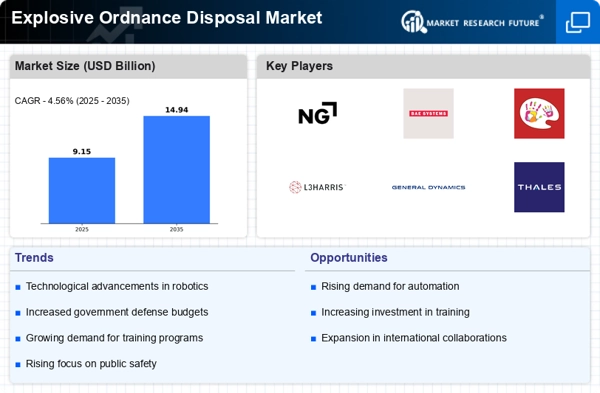North America : Defense Innovation Leader
North America is the largest market for Explosive Ordnance Disposal Market (EOD), holding approximately 45% of the global share. The region's growth is driven by increasing defense budgets, technological advancements, and heightened security concerns. Regulatory support from government agencies, including the Department of Defense, further catalyzes market expansion. The demand for advanced EOD solutions is expected to rise as military operations evolve and the threat landscape changes. The United States is the dominant player in this market, with significant contributions from companies like Northrop Grumman, L3Harris Technologies, and General Dynamics. Canada also plays a vital role, focusing on enhancing its EOD capabilities. The competitive landscape is characterized by innovation and collaboration among key players, ensuring that North America remains at the forefront of EOD technology and solutions.
Europe : Emerging Defense Collaborations
Europe is witnessing a growing demand for Explosive Ordnance Disposal Market (EOD) solutions, accounting for approximately 30% of the global market. The region's growth is fueled by collaborative defense initiatives, increased military spending, and a focus on enhancing national security. Regulatory frameworks, such as the European Defense Fund, are pivotal in supporting research and development in EOD technologies, driving innovation and market expansion. Leading countries in this region include the United Kingdom, Germany, and France, with key players like BAE Systems, Rheinmetall, and Thales Group. The competitive landscape is marked by strategic partnerships and joint ventures aimed at developing advanced EOD systems. As European nations prioritize defense capabilities, the EOD market is expected to grow significantly, reflecting the region's commitment to security and technological advancement.
Asia-Pacific : Rapidly Growing Defense Sector
Asia-Pacific is emerging as a significant player in the Explosive Ordnance Disposal Market (EOD) market, holding around 20% of the global share. The region's growth is driven by increasing military expenditures, geopolitical tensions, and the need for enhanced security measures. Countries are investing in advanced EOD technologies to address rising threats, supported by government initiatives and regulatory frameworks that promote defense modernization and capability enhancement. Key countries in this region include India, Japan, and Australia, with a competitive landscape featuring companies like Kongsberg Gruppen and Elbit Systems. The presence of these key players is crucial as they develop innovative EOD solutions tailored to regional needs. As defense budgets continue to rise, the Asia-Pacific EOD market is poised for substantial growth, reflecting the region's strategic focus on security and defense capabilities.
Middle East and Africa : Strategic Defense Investments
The Middle East and Africa (MEA) region is witnessing a burgeoning demand for Explosive Ordnance Disposal Market (EOD) solutions, accounting for approximately 5% of the global market. This growth is driven by ongoing conflicts, terrorism threats, and increased military spending by various nations. Regulatory support from regional governments is essential in fostering the development of EOD capabilities, ensuring that security forces are equipped to handle explosive threats effectively. Leading countries in this region include Saudi Arabia, the UAE, and South Africa, with a competitive landscape featuring local and international players. Companies are focusing on developing tailored EOD solutions to meet the unique challenges faced in the region. As security concerns escalate, the MEA EOD market is expected to grow, reflecting the strategic importance of defense investments in ensuring regional stability.


















Leave a Comment